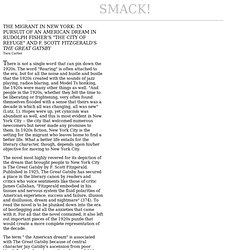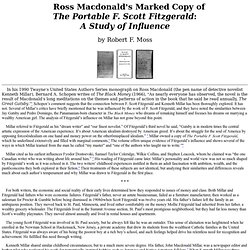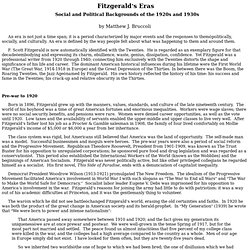

Tara Carter's Thesis. THE MIGRANT IN NEW YORK: IN PURSUIT OF AN AMERICAN DREAM IN RUDOLPH FISHER'S "THE CITY OF REFUGE" AND F.

SCOTT FITZGERALD'S THE GREAT GATSBYTara Carter There is not a single word that can pin down the 1920s. The word "Roaring" is often attached to the era, but for all the noise and hustle and bustle that the 1920s created with the sounds of jazz playing, radios blaring, and Model Ts honking, the 1920s were many other things as well. "And people in the 1920s, whether they felt the time to be liberating or frightening, very often found themselves flooded with a sense that theirs was a decade in which all was changing, all was new" (Lutz, 1). Hopes were up, yet cynicism was abundant as well, and this is most evident in New York City -- the city that welcomed numerous newcomers but never made any promises to them. The novel most highly revered for its depiction of the dream that brought people to New York City is The Great Gatsby by F. e24176.
Macdonald / The Portable F. Scott Fitzgerald. Millar referred to Fitzgerald as his “dream writer” and “our finest novelist.”

Of Fitzgerald’s third novel he said, “Gatsby is in modern times the central artistic expression of the American experience. It’s about American idealism destroyed by American greed. It’s about the struggle for the soul of America by opposing forcesòidealism on one hand and money power on the otheròmisplaced idealism.” 2 Millar owned a copy of The Portable F. Scott Fitzgerald, which he underlined extensively and filled with marginal comments.3 The volume offers unique evidence of Fitzgerald’s influence and shows several of the ways in which Millar learned from the man he called “my master” and “one of the authors who taught me to write.”4 Millar cited as his earliest influences Fyodor Dostoevski, Samuel Taylor Coleridge, Wilkie Collins, and Stephen Leacock, whom he claimed was “the one Canadian writer who was writing about life around him.”5 His reading of Fitzgerald came later.
Fitzgerald's Eras. By Matthew J.

Bruccoli An era is not just a time span; it is a period characterized by major events and the responses to themòpolitically, socially, and culturally. An era is defined by the way people felt about what was happening to them and around them. F. Scott Fitzgerald is now automatically identified with the Twenties. Dwelling in the Text. The Great Gatsby: Context. Francis Scott Key Fitzgerald was born on September 24, 1896, and named after his ancestor Francis Scott Key, the author of “The Star-Spangled Banner.”

Fitzgerald was raised in St. Paul, Minnesota. Though an intelligent child, he did poorly in school and was sent to a New Jersey boarding school in 1911. Despite being a mediocre student there, he managed to enroll at Princeton in 1913. Academic troubles and apathy plagued him throughout his time at college, and he never graduated, instead enlisting in the army in 1917, as World War I neared its end.
Fitzgerald became a second lieutenant, and was stationed at Camp Sheridan, in Montgomery, Alabama. Many of these events from Fitzgerald’s early life appear in his most famous novel, The Great Gatsby, published in 1925. Having become a celebrity, Fitzgerald fell into a wild, reckless life-style of parties and decadence, while desperately trying to please Zelda by writing to earn money. FREE Study Guide: The Great Gatsby/Summary by F. Scott Fitzgerald / Analysis / Book Notes / Free BookNotes / Online / Download.